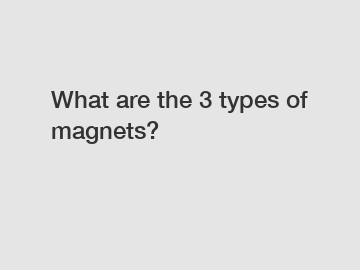What are the 3 types of magnets?
Magnets have fascinated humanity for centuries with their extraordinary properties and numerous practical applications. Used in various industries, from technology to medicine, magnets are an integral part of our daily lives. While most of us are familiar with the traditional magnets found on our refrigerators, there are actually three distinct types of magnets that differ in their composition and magnetic behavior. In this article, we will explore the three types of magnets to gain a deeper understanding of their unique characteristics and uses.
1. Permanent Magnets:
Permanent magnets, as the name suggests, retain their magnetic properties over a long period of time but require an external force to magnetize them. The two main types of permanent magnets are Ferrite and Alnico magnets.

a) Ferrite Magnets:
Ferrite magnets, popularly known as ceramic magnets, are composed of iron oxide mixed with ceramic materials. These magnets are relatively inexpensive, possess high coercivity (resistance to demagnetization), and display excellent corrosion resistance. However, they have lower magnetic strength compared to other types of magnets, making them ideal for applications where a weaker magnetic field is sufficient. Ferrite magnets are commonly found in audio speakers, electric motors, and appliances.
b) Alnico Magnets:
Alnico magnets are comprised of aluminum, nickel, and cobalt, along with smaller amounts of iron and other elements. These magnets have a higher magnetic strength than ferrite magnets and exhibit good temperature stability. Additionally, their unique properties make them resistant to corrosion. Alnico magnets find applications in electric guitars, sensors, and various industrial settings such as magnetic clamps and motors.
2. Temporary Magnets:
Temporary magnets are made from soft magnetic materials and can be easily magnetized and demagnetized. They possess a magnetic field only when exposed to an external magnetic field or a strong electric current. Two primary types of temporary magnets are Electromagnets and Superconducting Magnets.
a) Electromagnets:
Electromagnets are magnets that generate a magnetic field when a current flows through a coil or wire. By adjusting the current flow, we can control the strength of the magnetic field. Electromagnets are widely used in various everyday applications such as MRI machines, relays, speakers, and even cranes operating in scrapyards. The ability to control the strength of the magnetic field makes electromagnets extremely versatile and practical.
b) Superconducting Magnets:
Superconducting magnets are the most advanced type of temporary magnets, and they require extremely low-temperature conditions (often near absolute zero) to exhibit superconductivity. Superconductivity is a unique phenomenon in which electrical resistance vanishes, resulting in strong and persistent magnetic fields. These magnets are utilized in research laboratories, particle accelerators, and magnetic resonance imaging (MRI) systems. Superconducting magnets offer incredibly high magnetic fields, but their production and use are complex and expensive.
3. Temporary and Permanent Magnets:
Hybrid magnets combine features of both temporary and permanent magnets. These magnets can be magnetized and demagnetized while maintaining some level of magnetism. They are predominantly used in data storage devices, such as hard drives, where magnetism needs to be manipulated regularly.
Conclusion:
Magnets are truly remarkable creations of nature, fostering countless advancements across various industries. Whether it's the powerful and enduring permanent magnets like Ferrite and Alnico, or the versatile temporary magnets like Electromagnets and Superconducting Magnets, each type offers distinct properties and applications. By understanding the differences and applications of these three types of magnets, we can further appreciate the role they play in our modern world, from basic household items to life-saving medical devices and beyond.
If you are looking for more details, kindly visit Magnet Chamfer China Supplier, Magnetic Shuttering Solution, Physical Properties For Sintered Neodymium Magnets.

Comments
0